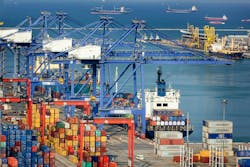Import Cargo Could Surge Ahead of Potential Port Strike and Tariffs
As retailers face another potential East Coast/Gulf Coast port strike and tariff increases planned by President-elect Donald Trump, import volumes at the nation’s major container ports could be higher than previously expected for the remainder of this year according to the Global Port Tracker report released on November 8 by the National Retail Federation and Hackett Associates.
“October’s strike lasted only three days but there’s the potential for a longer strike if a new labor contract is not reached after the contract extension runs out in mid-January,” NRF Vice President for Supply Chain and Customs Policy Jonathan Gold said, in a statement. “That has retailers spending extra to bring in cargo early or continue shifting it to the West Coast to avoid any potential disruptions, much like they did earlier this year.
"And we’re hearing that some merchants will also move up shipments to avoid the costly tariff increases expected after Donald Trump returns to the White House. Neither of these developments is good for retailers, their customers or the economy.”
An NRF study released this week found that tariff increases proposed by Trump could drive up consumer prices by as much as $78 billion a year.
And the contract that The International Longshoremen’s Association made with the U.S. Maritime Alliance will be under formal negotiations next week.
Hackett Associates Founder Ben Hackett said the potential for a January strike “can be seen in the continuing increases in U.S. imports from Asia, which have not fallen away as expected.” And worries over higher tariffs are a global concern, he said.
“We are witnessing elections around the world where discontent is leading to inward-looking policies that threaten trade with the almost certain potential for increasing tariffs,” Hackett said, in a statement. “In the United States, this is particularly true with the election of Donald Trump, but it is not much different in Europe, with the EU calling for tariffs to be applied to a growing number of products from China.”
U.S. ports covered by Global Port Tracker handled 2.29 million Twenty-Foot Equivalent Units in September, although the Ports of New York/New Jersey and Miami have yet to report final data. That was down 1.3% from August but up 12.8% year over year.
Ports have not yet reported October’s numbers, but Global Port Tracker projected the month at 2.13 million TEU, up 3.7% year over year. November is forecast at 2.15 million TEU, up 13.6% year over year, and December at 1.99 million TEU, up 6.1%. That would bring 2024 to 25.3 million TEU, up 13.6% from 2023.
The numbers have not yet been revised to reflect this week’s election results but do take the potential port strike into consideration. October was previously forecast at 2.12 million TEU, November at 1.91 million TEU and December at 1.88 million TEU, and the total for 2024 was previously forecast at 24.9 million TEU.
January 2025 is forecast at 2.01 million TEU, up 2.5% year over year; February at 1.77 million TEU, down 9.3% because of fluctuations in the timing of Lunar New Year shutdowns at Asian factories, and March at 2.01 million TEU, up 4.4%.

